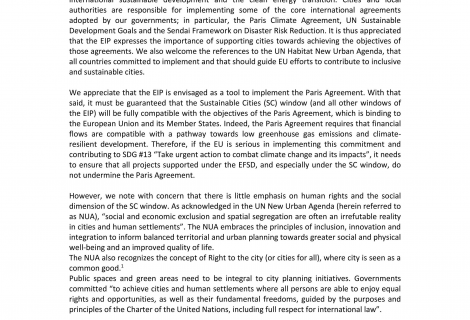
People living in cities all over the world are becoming more active agents of change in international sustainable development and the clean energy transition. Cities and local authorities are responsible for implementing some of the core international agreements adopted by our governments; in particular, the Paris Climate Agreement, UN Sustainable Development Goals and the Sendai Framework on Disaster Risk Reduction. It is thus appreciated that the EIP expresses the importance of supporting cities towards achieving the objectives of those agreements. We also welcome the references to the UN Habitat New Urban Agenda, that all countries committed to implement and that should guide EU efforts to contribute to inclusive and sustainable cities.
We appreciate that the EIP is envisaged as a tool to implement the Paris Agreement. With that said, it must be guaranteed that the Sustainable Cities (SC) window (and all other windows of the EIP) will be fully compatible with the objectives of the Paris Agreement, which is binding to the European Union and its Member States. Indeed, the Paris Agreement requires that financial flows are compatible with a pathway towards low greenhouse gas emissions and climate-resilient development. Therefore, if the EU is serious in implementing this commitment and contributing to SDG #13 "Take urgent action to combat climate change and its impacts", it needs to ensure that all projects supported under the EFSD, and especially under the SC window, do not undermine the Paris Agreement.
However, we note with concern that there is little emphasis on human rights and the social dimension of the SC window. As acknowledged in the UN New Urban Agenda (herein referred to as NUA), "social and economic exclusion and spatial segregation are often an irrefutable reality in cities and human settlements". The NUA embraces the principles of inclusion, innovation and integration to inform balanced territorial and urban planning towards greater social and physical well-being and an improved quality of life. The NUA also recognizes the concept of Right to the city (or cities for all), where city is seen as a common good.' Public spaces and green areas need to be integral to city planning initiatives. Governments committed "to achieve cities and human settlements where all persons are able to enjoy equal rights and opportunities, as well as their fundamental freedoms, guided by the purposes and principles of the Charter of the United Nations, including full respect for international law".